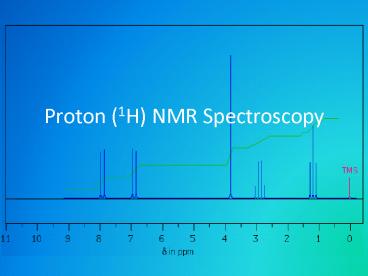Proton (1H) NMR Spectroscopy - PowerPoint PPT Presentation
1 / 18
Title:
Proton (1H) NMR Spectroscopy
Description:
Proton (1H) NMR Spectroscopy Proton nuclear magnetic resonance Click on the link on the icon below to view a video introducing NMR spectroscopy. – PowerPoint PPT presentation
Number of Views:1083
Avg rating:3.0/5.0
Title: Proton (1H) NMR Spectroscopy
1
Proton (1H) NMR Spectroscopy
2
Proton nuclear magnetic resonance
Click on the link on the icon below to view a
video introducing NMR spectroscopy.
3
How are spectra created?
The compass needle aligns with the Earths
magnetic field and points north.
The needle will swing back as soon as the energy
is removed.
When energy is put in, the needle can be made to
align in a direction opposite to the Earths
magnetic field.
Nuclei behave like tiny magnets similar to a
compass needle.
4
- When an external magnetic field is applied,
hydrogen nuclei can align with the external field
or against it.
Nucleus aligned opposed to magnetic field
high-energy state.
External magnetic field
?E radio waves
Nucleus aligned with magnetic field low-energy
state.
- As nuclei relax back to the low-energy alignment,
energy in the radio wave frequency is released.
This energy is detected and recorded as peaks on
a spectrum.
5
Proton environments
- In a compound, the protons are bonded to other
atoms and so there are more electrons in the
region of the protons. - These electrons affect the external magnetic
field experienced by the proton. - The energy gap between high- and low-energy
states will be slightly different. - The frequency of radiation emitted as the nuclei
relax back to the low-energy state will also be
different. - Protons emitting radiation of the same frequency
are said to be in the same proton environment.
6
Determining proton environments
- Example How many proton environments are there
in ethanol?
The OH proton is in a third environment.
The three CH3 protons are in one environment.
The two CH2 protons are in a second environment.
7
Preparing a sample
- To obtain the 1H NMR spectrum of a sample it is
usually necessary to dissolve the sample in a
solvent. - Solvents must not contain protons that will
interfere with the sample being measured. - A solvent must
- contain no hydrogen atoms, eg tetrachloromethane,
CCl4 - or
- have the hydrogen atoms replaced with deuterium
(2H), eg CDCl3 or CD3OD.
8
Explaining spectra
TMS (tetramethylsilane) is added to the solvent
and provides a reference peak. The protons in TMS
are assigned the value 0 ppm and the rest of the
spectrum is calibrated relative to this.
The scale runs from right to left and is called
the chemical shift. It is measured in parts per
million (ppm). Peaks to the left of TMS peak are
said to be downfield of TMS.
9
Interpreting low-resolution1H NMR spectra
- Points to note
- Each peak in a low-resolution spectrum represents
one proton environment. - The type of proton environment can be identified
by looking up the chemical shift in a correlation
table (data book). - The area under the peak relates to the number of
protons in the environment.
10
Example 1
Methyl ethanoate
11
By comparing the heights of the integration
curves we can determine the ratio of protons in
each environment.
The area under the peak gives information about
how many protons are in each environment.
In this spectrum the height ratio is 11 so there
is an equal number of protons in each environment.
The area is given as an integration curve and the
height of the curve can be measured.
12
Solving problems
- It is helpful to lay out your interpretations in
a table.
Peak shift (ppm) Integration height (mm) Ratio
2.1 30 1
3.8 30 1
13
High resolution
- High-resolution spectra are run using a higher
radio frequency and the peaks have more detail. - Compare the spectra below for methyl propanoate.
High-resolution NMR for methyl propanoate.
Low-resolution NMR for methyl propanoate.
14
This spectrum is for pentan-3-one. The peaks show
that there are two proton environments. Can you
assign these peaks to the structure?
CH3
CH2
15
When the spectrum is expanded it can be seen that
each peak is made up of a number of peaks. These
are called multiplets.
Quartet four peaks in the group.
Triplet three peaks in the group.
Other multiplets include singlets and doublets.
16
n 1 rule
- The number of peaks in a multiplet can give
additional information about the structure. - The splitting of peaks is caused by the
neighbouring carbons hydrogen atoms. - Protons in the same environment are said to be
equivalent and as such behave as one proton. - This follows the n 1 rule.
- n is the number of hydrogen atoms attached to the
next-door carbon - n 1 is how many peaks will be seen in the
cluster.
17
CH3CH2COCH2CH3
CH3
CH2
Split by 2 protons on next-door carbon, so n
2, n 1 3 peaks.
Split by 3 protons on next-door carbon so n
3, n 1 4 peaks.
18
Example 2 Assign the peaks and suggest a
structure
Molecular formula C3H7Br































